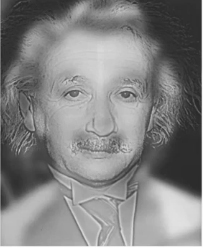Visual illusion reveals your degree of eyesight
Take a look at the picture below at the distance of normal observation before the screen, if you don't see the face of genius physicist Albert Einstein, but instead the face of the legendary queen Hollywood Marilyn Monroe You may have to see an ophthalmologist because of poor vision.
Vision test with visual illusion
According to experts, at normal distance, healthy eyes need to recognize the clear lines of Einstein's face, making the brain at the same time reject that image of Marilyn Monroe. The opposite will happen when you have poor eyesight and need to wear glasses to see better .
 Albert Einstein or Marilyn Monroe?
Albert Einstein or Marilyn Monroe?
The classic visual illusion was created many years ago by neuroscientists at Massachusetts Institute of Technology (MIT). In a newly released video, AsapScience revealed a trick to create this illusion.
"Depending on how well you can focus or identify the contrast, your eyes will select the details. When near the image, we will often see the details clearly. Like Einstein's beard or wrinkles, however, when distance increases or if your eyesight is poor and creates a more fuzzy image, your ability to acquire details will disappear. You will only see the overall features, like the shape of the mouth, nose and hair, and will eventually see the image of Marilyn Monroe, "AsapScience explained.
The MIT team, led by Dr. Aude Oliva, has spent more than a decade creating " hybrid " visual illusions , in which images can be hidden in layouts, scripts and other objects. . The " Marilyn Einstein" illusion was born through inhibition to superimpose a blurred image of Marilyn Monroe onto a picture of Albert Einstein clearly drawn.
Characteristics with high spatial frequencies are only apparent when observing them at close range . In contrast, the characteristics with low spatial frequencies are clearly visible at a distance. The combination of the two photos created a transformative image when the observer moved closer or further away from the screen.
Dr. Oliva said, such hybrid images not only reveal vision problems, but also highlight how the brain processes information.
Through experiments, Dr. Oliva realized that our brains distinguished reception of clear details in certain situations, and wider details in other situations . The process of processing the details of the brain occurs slightly slower than the process of handling other features.
- Visual illusion 'brain pain' most: This picture is white, or black background?
- Experience the world's most powerful visual illusion
- Roll on all kinds of visual illusions that cheat the brain
- Find out exactly what the animal is hiding in this picture
- Looking at this illusion, do you realize this is a car door or a beach after a storm?
- Decode the mystery that makes Venus look bigger than Jupiter
- Illusion of concave house background deceiving many people
- Only 10% of people can find 9 faces in this picture, what about you?
- Visual illusions make you
- Guaranteed visual fool beams will surprise you
- Visual illusions 'dangerous' than the dress Blue Black - White Gold
- Set of visual illusion paintings that make viewers' not know when
 'Fine laughs' - Scary and painful torture in ancient times
'Fine laughs' - Scary and painful torture in ancient times The sequence of numbers 142857 of the Egyptian pyramids is known as the strangest number in the world - Why?
The sequence of numbers 142857 of the Egyptian pyramids is known as the strangest number in the world - Why? History of the iron
History of the iron What is alum?
What is alum? Hubble telescope captures image of 'bridge' connecting two galaxies
Hubble telescope captures image of 'bridge' connecting two galaxies  What does the edge of the universe look like?
What does the edge of the universe look like?  Spectacular set of images of galaxies and nebulae taken by James Webb telescope
Spectacular set of images of galaxies and nebulae taken by James Webb telescope  The image of '2 suns' appeared in the sky of Hanoi
The image of '2 suns' appeared in the sky of Hanoi  The phenomenon of 'two suns' appears again in Quang Ngai
The phenomenon of 'two suns' appears again in Quang Ngai  This chip is less than 1 square centimeter processing 2 billion images per second
This chip is less than 1 square centimeter processing 2 billion images per second 